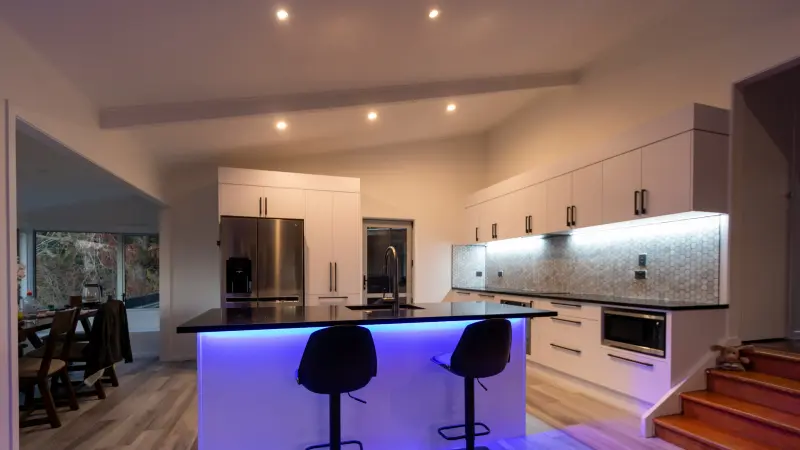Disclosure: This post may contain affiliate links, meaning we get a commission if you decide to make a purchase through our links, at no cost to you. Please read our disclosure for more info.
Lighting significantly influences how we experience and interact with our surroundings. Advances in technology and increasing awareness of energy use have driven significant changes in the industry. Traditional incandescent bulbs, while common for many years, have notable drawbacks. Rising energy costs, maintenance challenges, and a growing focus on environmental sustainability have prompted individuals and businesses to explore better lighting options.
LED lighting systems offer a practical alternative to traditional bulbs. This flexible lighting system delivers significant energy savings, longer lifespans, and reduced maintenance needs. Transitioning to LED technology provides everyday benefits, from lowering costs to improving safety in various settings.
In This Post:
Energy Efficiency: Lower Consumption and Greater Savings
LEDs consume up to 80% less electricity than traditional incandescent bulbs, making them highly efficient. A single 10-watt LED bulb can replace a 60-watt incandescent bulb while providing the same brightness, leading to noticeable reductions in energy consumption. This efficiency translates to lower electricity bills and significant long-term savings in both residential settings and commercial operations, such as warehouses or retail stores, where lighting runs for extended hours.
Although the upfront cost of LED lighting may be higher, the long-term financial advantages become evident when factoring in their energy efficiency and longevity. Reduced energy use enables households and businesses to recover their investment quickly. As sustainable practices gain momentum, switching to LED lights aligns with economic and environmental priorities.
Extended Lifespan and Reduced Maintenance Costs
The longevity of LED lighting systems sets them apart from incandescent bulbs. With lifespans ranging from 25,000 to 50,000 hours, LEDs last significantly longer than the 1,000 hours typical of traditional bulbs. This durability means fewer replacements and a more consistent, reliable lighting source.
Lower maintenance needs also translate to cost savings, especially for businesses or spaces with extensive lighting setups. LEDs, lasting up to 50,000 hours or more, drastically reduce the frequency of replacements and associated labor costs. Their durability and consistent performance make LED technology an excellent choice for high-traffic areas like airports, hospitals, or large-scale office buildings, where reliability and efficiency are must-haves.
Environmental Benefits of LED Lighting
By consuming less energy, LED lights help reduce greenhouse gas emissions, supporting efforts to combat climate change and improve air quality. Switching from energy-intensive incandescent bulbs to more efficient LEDs can lower electricity consumption by up to 75%, significantly decreasing harmful emissions. Each household making the switch saves approximately 1,800 kilowatt-hours over the lifespan of an LED bulb.
LEDs also stand out for their environmentally friendly construction. Unlike traditional bulbs, they avoid hazardous materials, making them safer to dispose of and less harmful to the environment. This feature supports sustainable practices and encourages responsible energy use, reflecting a commitment to a cleaner future.
Versatility and Adaptability in Lighting Solutions
LEDs provide instant brightness, making them ideal for environments requiring immediate light. In emergency stairwells, for instance, this quick response improves safety by removing delays in visibility during evacuations or power outages. Their ability to deliver full brightness as soon as they are activated allows individuals to manage safely without hesitation, minimizing risks in high-stress situations.
Their wide range of color temperatures provides options for different settings, from warm tones for cozy spaces to cool hues for task-oriented environments. Dimming capabilities add further adaptability, allowing tailored lighting for various moods and activities. This versatility makes LEDs suitable for both everyday home use and specialized applications in industrial or decorative projects.
Improved Safety and Reliable Performance
Operating at lower temperatures, LED lights reduce fire risks associated with the heat generated by incandescent bulbs. For instance, LEDs often operate at temperatures below 50°C, compared to incandescent bulbs, which can reach over 200°C. Minimal heat output keeps surrounding surfaces cool, making LEDs a safer option for homes, offices, and public areas.
LEDs also perform reliably under extreme conditions, withstanding shock, vibration, and temperature fluctuations. This resilience maintains consistent lighting in demanding environments, whether outdoors in harsh weather or indoors in industrial settings. Their dependability makes LEDs a top choice for safety-vital applications, such as emergency lighting and security systems.
LED lighting offers a transformative solution for modern energy and sustainability challenges. With up to 80% lower energy consumption, lifespans exceeding 25,000 hours, and reduced maintenance needs, LEDs provide both immediate and long-term benefits. Their adaptability suits diverse applications, from homes to large-scale facilities, while their environmental advantages, like lower greenhouse gas emissions and safe disposal, support global sustainability goals. Transitioning to LED lighting is a practical step toward cost savings, enhanced safety, and a reduced environmental footprint. Begin with key areas, such as high-use or vital spaces, to maximize impact while enjoying the benefits of this efficient technology.


